Gorging the Senses on Gorge Lake
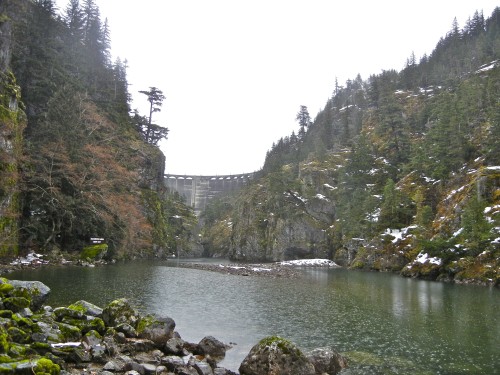
Though I moved to the Environmental Learning Center last August, I had visited many times before during my first summer while living in Bellingham as a graduate student in North Cascades Institute and Western Washington University’s M.Ed. program. Each time I drove by Gorge Lake, I marveled at the huge sand banks with gigantic tree trunks, remnants from before the dam was constructed and the gorge was flooded. One of three manmade reservoirs on the Skagit River, Gorge Lake is part of the Skagit River Hydroelectric Project. Built in 1921, it makes up one third of a three-part system that helps power the city of Seattle. The two other parts of that system are Diablo and Ross Dams, with their consequent lakes.
During the warmer summer and fall seasons, the utility company, Seattle City Light, keeps the Gorge Lake water level relatively low, making the lake bed look like a vast expanse on a foreign planet. Not long after I moved up to the Environmental Learning Center in September, Seattle City Light raised the water level in Gorge Lake. The Skagit River in winter, without the addition of glacial flour scoured from the mountains above, is a dark emerald green that begs for exploration.
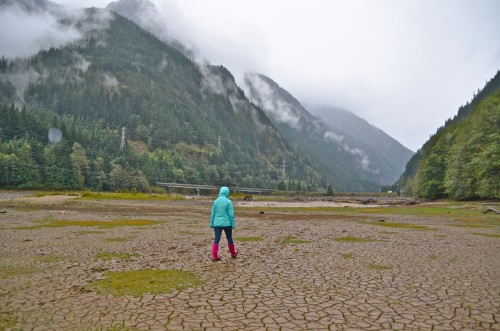 Graduate student Tyler Chisholm explored the cracked surface of the de-watered Gorge Lake last fall, looking for signs of a moose who some encountered visiting the town of Diablo. Photo by author.
Graduate student Tyler Chisholm explored the cracked surface of the de-watered Gorge Lake last fall, looking for signs of a moose who some encountered visiting the town of Diablo. Photo by author.
I recently had the opportunity to canoe the lake with some friends, and though it was a drizzly day, the company was warm and light. We started in the town of Diablo, close to the bottom of the Diablo Dam. Two in our company, Dylan and Max, were advanced paddlers, which made for an easy learning experience for the rest of us who all came with varying degrees of canoeing know-how. Starting close to the dam was a wonderful idea as it gave us a new perspective of the small, company town as we floated by. The Diablo Power House, built into the rock wall, seemed so much more impressive on water than it did on land.
As we floated down lake, we came to a small section of white water where Stettatle Creek meets with the mighty Skagit. My canoe partner, Max, gave me a few quick pointers before we entered the waves and we floated down easily without much duress, bumping and tossing as the flow pushed us here and there. As we shot out the other end, Max and I let out a WHOOP! It was a short bit of rapids, enough to keep us on our toes and to be a ton of fun. We watched as Dylan, Annabel and Kristi expertly navigated the waves before paddling on toward where Highway 20 crosses the lake. On the other side of the massive bridge, we slowed down and meandered through stumps and sandbars that momentarily sit above the water line. We could see far through the deep green water, with visibility at ten or so feet. The sand bars above and below the water line had deep cracks in them, presumably due to the shifting level of the lake. The remainders of the stumps that we could see were old, large and teeming with new life. It is remarkable how quickly nature reclaims that which has been disturbed.
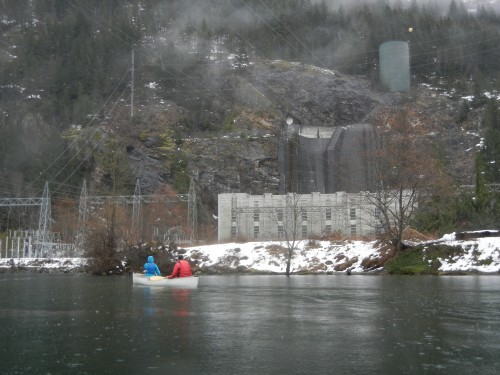 Graduate student Samantha Hale and Seasonal Naturalist Max Thomas paddle past the Diablo Power House. Despite its grey, concrete exterior, the inside is quite fancy, complete with marble and granite flooring, an art deco water fountain, and a tiled goldfish pool. Photo by Kristi Klinesteker.
Graduate student Samantha Hale and Seasonal Naturalist Max Thomas paddle past the Diablo Power House. Despite its grey, concrete exterior, the inside is quite fancy, complete with marble and granite flooring, an art deco water fountain, and a tiled goldfish pool. Photo by Kristi Klinesteker.
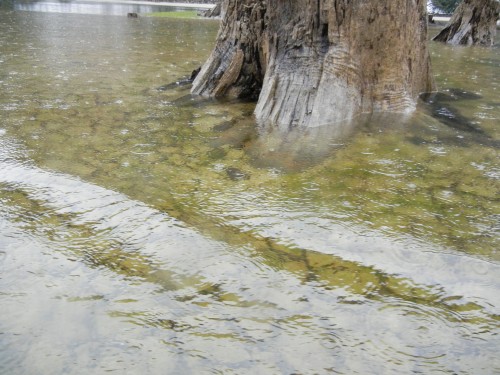 Stumps of old trees poke through the green waters of Gorge Lake, like 100-year-old ghosts lending paddlers an idea of what the landscape looked like before the dam and reservoir were constructed. Photo by Kristi Klinesteker.
Stumps of old trees poke through the green waters of Gorge Lake, like 100-year-old ghosts lending paddlers an idea of what the landscape looked like before the dam and reservoir were constructed. Photo by Kristi Klinesteker.
As we continued on our journey, we stopped here and there to explore the many waterfalls that feed into the lake. By this point, the drizzle had turned to full-blown rain, swelling the cascades around us, giving an even better idea at the amount of water coming off the land. No wonder they call this place the North Cascades. To make the occasion all the more special, it was Kristi’s birthday weekend, so we took our time meandering around some lakeside caves and waterfalls of all sizes and shapes. We continued on much farther than we had originally planned, finally coming to rest at the point where the Gorge Falls meets its namesake lake. The falls are impressive from the roadside, and even more so from the base. Climb as we did, it was too damp to get higher for a full view of the falls. However, there were many waterfalls closer to the lake that were equally as impressive and easier to access.
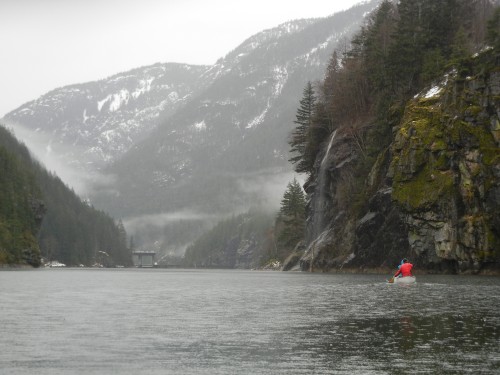 Chasing waterfalls: Thomas and Hale canoe past one cascade after another, meandering toward Gorge Dam up ahead. Photo by Kristi Klinesteker.
Chasing waterfalls: Thomas and Hale canoe past one cascade after another, meandering toward Gorge Dam up ahead. Photo by Kristi Klinesteker.
After a bit of playing in the snow and taking a plethora of pictures and “selfies”, we were on the water again. Before heading up lake we stopped to touch the massive 300 foot dam on our way back. I can now say I have seen and touched all three dams on the Skagit. On our return journey we hugged close to the opposite shore, investigating an equal number of waterfalls as well as avalanches and rock slides. Rain or shine, the day was exquisite, and I can’t wait to return to the Gorge Falls on a sunnier day. I would highly recommend this trip to anyone, but would suggest going when the water level is higher as it makes for a more relaxed journey.
Enjoy your weekends and get out exploring, my friends!
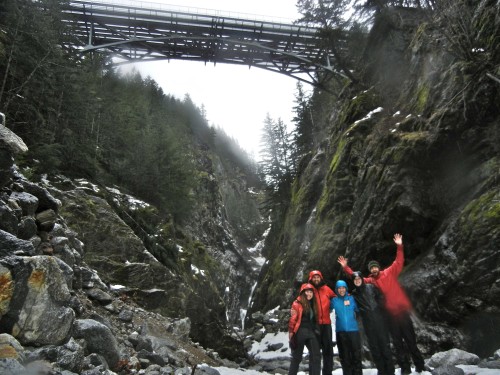
We made it to the Gorge Falls! From L to R: Kristi & Dylan Klinesteker, Samantha Hale, Annabel Connelly, and Max Thomas. Photo by Kristi Klinesteker.
Samantha Hale is a graduate student in North Cascades Institute and Western Washington University’s M.Ed. program. She has a background in marine mammal research and is ever in search, via canoe, of Diablo Lake’s elusive porca.

